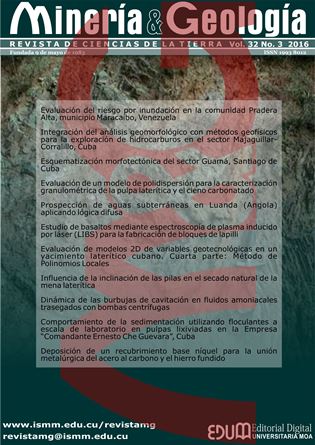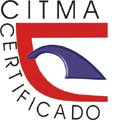Evaluation of Poly-dispersion Models for Grain Size Characterization of Laterite Slurries and Calcium Carbonate Mud
Keywords:
coeficiente de polidispersión, granulometría, pulpa laterítica, cieno carbonatado, modelos matemáticos.Abstract
The investigation evaluated the capability of the mathematical model proposed by Pérez (2010) to describe poly-dispersion in hydro-mixtures for diverse cases of grain size frequency distributions. The efficacy of the model was assessed when investigating the raw materials required by the acid leach process to produce nickel sulphides: laterite slurries and calcium carbonate mud. The experimental grain size analysis was conducted by implementing two techniques: conventional screening and particle size analyzer (HORIBA). The results obtained from the application of computer-based techniques to generate mathematical models show that the model is capable to describe poly-dispersion in hydro-mixtures. It was concluded that poly-dispersion in calcium carbonate mud is higher than in laterite slurries.Downloads
References
AVRAMIDIS, K. S. & TURIAN, R. M. 1991: Yield stress of laterite suspensions. J. Colloid Interface Sci. 143(1): 54-62.
CERPA, A.; TARTAJ, P.; GARCÍA-GONZÁLEZ, M. T.; REQUENA, J.; GARCELL, L. R. & SERNA, C. J. 1996: Rheological properties of concentrated lateritic suspensions. Progr Colloi Polym Sci. 100: 266-270.
CERPA, A.; GARCÍA-GONZÁLEZ, M. T.; SERNA, C. J. & TARTAJ, P. 2001: Relationship between the colloidal and rheological properties of mineral suspensions. The Canadian Journal of Chemical Engineering 79(4): 608-611.
CERPA, A.; TARTAJ, P.; GARCÍA-GONZÁLEZ, M. T.; REQUENA, J.; GARCELL, L. & SERNA, C. J. 1999: Mineral-content and particle size effects on the colloidal properties of concentrate lateritic suspensions. Clays and Clay Minerals 47(4): 515-521.
FALCÓN, J. 2006: El beneficio de minerales y la separación de fases en las tecnologías limpias de la industria minero-metalúrgica. En: VII Clean Technology In The Mining Industry [Memorias]. Buzios, Río de Janeiro Brazil, octubre.
GARCELL, L.; MORALES, M. P.; ANDRES-VERGÉS, M.; TARTAJ, P. & SERNA, C. J. 1998: Interfacial and Rheological Characteristics of Maghemite Aqueous Suspensions. Journal of Colloid and Interface Science 205(2): 470-475.
HERNÁNDEZ, R. G; MARTÍNEZ, R. R.; DURÁN, A. C. & PÉREZ, A. O. 2015: Eficiencia energética en sistemas de bombeo de hidromezclas. Minería & Geología 31(3): 109-127.
HYAMS, D. 1997: CurveExpert, Versión 1.34 (Aplicación Informática). USA. http://web.archive.org/web/http://www.ebicom.net/~dhyams/cftp. htm
MADIGAN, C.; LEONG, Y. K. & ONG, B. C. 2009: Surface and rheological properties of as-received colloidal goethite (α-FeOOH) suspensions: pH and polyethylenimine effects. International Journal of Mineral Processing 93(1): 41-47.
MARTÍNEZ, R. R.; IZQUIERDO, I. & POMPA, M. 2014: Pérdida de carga durante el transporte en régimen laminar de pulpas de cieno carbonatado. Minería & Geología 30(1): 80-94.
MILLER, I.; FREUND, J. & JOHNSON, R. 2005: Probabilidades y Estadísticas para ingenieros. Volumen I y II. Cuarta Edición. Prentice-Hall Hispanoamericana S.A., México, 624 p. ISBN: 0-13-712-761-8.
PÉREZ, G. L. 2010: Modelo matemático que correlaciona los principales factores de influencia sobre el comportamiento reológico de las pulpas lateríticas. Leonel Garcell (Tutor). Tesis doctoral. Universidad de Oriente. 134 p.
Pérez, G. L. & Garcell, L. R. 2006: Influencia de la distribución de tamaño de las partículas y de la temperatura sobre la reología de suspensiones lateríticas. Tecnología Química 26(1): 88-93.
PÉREZ, G. L.; CARDERO, Y. & GARCELL, L. R. 2009: Modelo matemático para describir la distribución granulométrica de la fase dispersa de las suspensiones de laterita. Tecnología Química 29(2): 84-96.
RIVAS, S. & COLÁS, E. 2005: Efecto de la granulometría sobre la reología de suspensiones de cieno carbonatado. Trabajo de diploma. Universidad de Oriente. 61 p.
Published
How to Cite
Issue
Section
Copyright (c) 2016 Gabriel Hernández-Ramírez, Arístides Alejandro Legrá-Lobaina, Leonel Garcell-Puyans, Rodney Martínez-Rojas

This work is licensed under a Creative Commons Attribution-NonCommercial 4.0 International License.
- Authors retain copyright and guaranteeing the right magazine to be the first publication of the work as licensed under a Creative Commons Attribution-NonCommercial that allows others to share the work with an acknowledgment of the work's authorship and initial publication in this journal.
- Authors may establish separate supplemental agreements for the exclusive distribution version of the work published in the journal (eg, place it in an institutional repository or publish it in a book), with an acknowledgment of its initial publication in this journal.
- Authors are allowed and recommended to disseminate their work through the Internet (e.g., in institutional telematic archives or on their websites) before and during the submission process, which can produce interesting exchanges and increase citations of the published work. (See The effect of open access)










